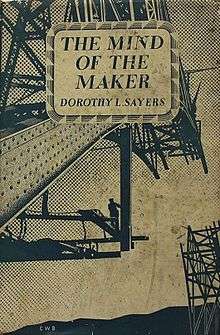The Mind of the Maker

First edition (publ. Methuen)
Cover art by C W B
Cover art by C W B
The Mind of the Maker (1941) is a Christian theological book, written by Dorothy L. Sayers (who was better known for her crime and mystery novels and other fiction, particularly for the character Lord Peter Wimsey). It used the experience she had of literary creativity to illuminate Christian doctrine about the nature of the Doctrine of the Trinity.[1]
The work has a Latin dedication to Saint Athanasius and to British Christian leaders.
Literary significance and criticism
Regarded in the Christian world as something of a classic, it is often quoted.
- "In The Mind of the Maker, one of her most profound works, Sayers contends that the creative process in art works in ways that correspond to the dynamic relation among the three Persons of the Trinity in Christian theology — and that the activity of one illuminates the activity of the other."[2]
Surprisingly well received, Sayers' work even finds readers beyond the religious world, such as in the software management book The Mythical Man-Month.
- "Dorothy Sayers, in her excellent book, The Mind of the Maker, divides creative activity into three stages: the idea, the implementation, and the interaction. A book, then, or a computer, or a program comes into existence first as an ideal construct, built outside time and space, but complete in the mind of the author. It is realized in time and space, by pen, ink, and paper, or by wire, silicon, and ferrite. The creation is complete when someone reads the book, uses the computer, or runs the program, thereby interacting with the mind of the maker. This description, which Miss Sayers uses to illuminate not only human creative activity but also the Christian doctrine of the Trinity, will help us in our present task.[3]
Footnotes
- ↑ The Mind of the Maker, preface
- ↑ Wolfe, Gregory (27 May 2005). "In God’s Image: The virtue of creativity". National Review online. Retrieved 2007-09-18.
- ↑ Brookes, Frederick P. jr. (1975). "The Mythical Man-Month: Essays on Software Engineering". Retrieved 2007-09-18.
References
- Sayers, Dorothy L. (1941). The Mind of the Maker (1st ed.). London: Methuen.
External links
- The Mind of the Maker at Faded Page (Canada)
- Online text of the book
This article is issued from
Wikipedia.
The text is licensed under Creative Commons - Attribution - Sharealike.
Additional terms may apply for the media files.